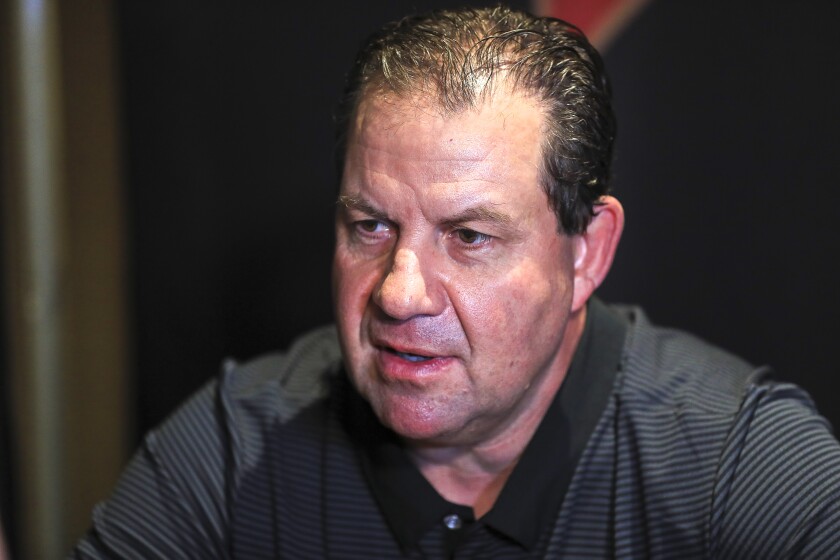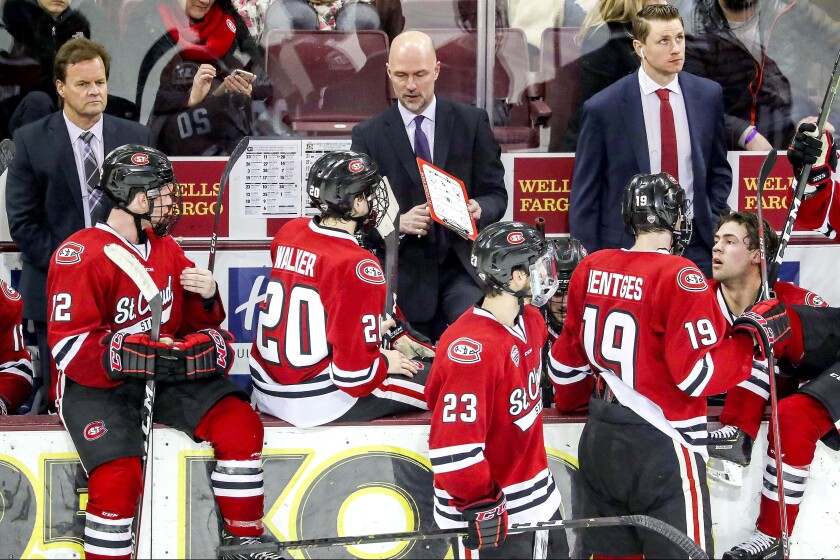Editor’s note: In the finale of a three-part series looking at the lives of NCAA Division I men’s hockey assistant coaches, what impact would a possible third full-time assistant coach make if the NCAA would allow it? Part 1 of the series — which covers the challenges faced by modern day assistants — Part 2 — which looks at how recruiting has become a year round job — can be read here.
Playing for his hometown Minnesota Duluth Bulldogs during the first half of the ’90s, current St. Cloud State head coach Brett Larson remembers the assistants of head coach Mike Sertich each having a distinct role when it came to recruiting.
ADVERTISEMENT
Jim Knapp was always with the team. He’d recruit locally. Meanwhile, Glenn Kulik was on the road nonstop.
“I felt like there were months I never even saw Glenn,” Larson said.
These days it’s rare in college hockey to find a staff where one assistant coach pounds the pavement — and skies — while the other just coaches. Instead, the responsibility to scout and recruit players is spread amongst the entire three-person coaching staff. Today’s NCAA Division I men’s hockey assistant coaches take turns hitting the road in search of talent, a week at a time.
The death of month-long trips — at least in-season — doesn’t mean players are seeing all their coaches on the ice more often, however. With high school games to catch during the week and then junior games and midget tournaments on weekends, head coaches have found themselves alone on the ice at times working with 28-30 student athletes while their assistants are out recruiting.
That’s why coaches in the NCHC, such as Larson, would like to see the NCAA allow programs to have a third full-time assistant coach on staff. Teams are currently only allowed two full-timers and then a volunteer assistant — who often serves as a goaltending coach, working with netminders separately before or after practices.
Larson and others who support the addition of a third full-time assistant said it would improve the student-athlete experience on and off the ice, and help keep good coaches — who would like to spend less time on the road recruiting, and more time at home with their families — in the game longer.
“We really need to keep pushing for a third assistant. I think it's critical for college hockey,” said Larson, who was an assistant at UMD (2008-11, 2015-18) and Ohio State (2013-15) before taking over the Huskies program in 2018. “There are times where the only coach on the rink is your head coach at practice, and that's not good for player safety or for development. We need to have at least two coaches on the rink with these players. A 1-to-28 ratio at times isn't good enough. It doesn't happen too often, but when it does, I think it's a disservice to the players.
ADVERTISEMENT
“We need to really push for that third assistant to retain really good assistants, to keep them in the game, and to give the student-athletes a better and better experience on the ice.”
Financial battle
North Dakota head coach Brad Berry, who was an assistant at UND for nine seasons (2000-06, 2012-15) before taking the head job in 2015, said the topic of a third full-time assistant coach comes up every year during the NCHC’s yearly meetings, as well as during the annual NCAA Division I coaches meeting at the American Hockey Coaches Association convention in Florida — that was cancelled this year due to the COVID-19 pandemic. It has yet to gain the necessary support in the sport.
Opposition by other schools to adding a third full-time assistant coach is mostly financial. Not every program can afford to pay another full-time assistant coach, while those smaller budget programs that could afford to add another staffer may not be able to pay that person as much as other programs. A pay discrepancy among assistants at smaller and larger-budget schools already exists, and adding a third full-timer would only put those smaller programs at a further competitive disadvantage.

Of course, every athletic department is now in a budget crunch thanks to a coronavirus pandemic that is showing no signs of slowing down, at least in the United States. That makes the addition of a third full-time assistant even more unlikely for the foreseeable future, despite the need.
“We’re very sensitive on financial budgets of institutions and different things, but we find that you almost get overwhelmed dealing with 27-28 players, and some organizations have up to 30 players on their team,” said Berry, who would like to use the extra staffer in more of a developmental role with players rather than add another recruiter. “When you look at not just practicing, but you're looking at the academic side of it as far as making sure that they're getting a great education and support through their four years of college — and just the other student-athletes and taking care of them — you need an extra person in your group.”
ADVERTISEMENT
Bulldogs head coach Scott Sandelin, an assistant at North Dakota for six seasons (1994-2000) before taking over UMD in 2000, is in support of the NCAA permitting a third full-time assistant coach for many of the same reasons cited by his former UND teammate, Berry, and his former assistant, Larson, and for another reason.
After being hired by Dean Blais at North Dakota shortly after his professional playing career came to an end, Sandelin said “opportunity” is always on his mind when hiring a new assistant coach. That is why he would support the NCAA allowing teams to hire graduate assistant coaches as a compromise in the quest to expanding coaching staffs.
“If we can't get a third assistant right away, I would really love to have the opportunity that a program can have a grad assistant or two, because it gives those guys an opportunity to get involved, maybe be on the ice and get going with coaching,” said Sandelin, who has given former Bulldogs Larson, Derek Plante (2010-15) and Adam Krause (2018-present) their first coaching jobs in the last 12 years. “A lot of those guys are going to be your alumni that you want around your program, you want around your players.”

More than a stepping stone
Sandelin is in the process of wrapping up an assistant coach search after associate head coach Jason Herter — another rookie college assistant hired by Sandelin back in 2011 — stepped down in late April after nine seasons at UMD. While looking to pursue other opportunities in hockey at the moment, Herter didn’t rule out a return to the college game someday.
And he wouldn’t be the first to step away, only to be lured back on campus.
ADVERTISEMENT
Mike Gibbons, who retired this spring after 24 seasons as an NCAA Division I assistant at four schools, took a 13-season break to coach in juniors, the American Hockey League and at Eastview High �������� in Apple Valley, Minnesota, before capping his career with 13 seasons at St. Cloud State.

Berry rejoined the North Dakota staff as an assistant again in 2012 after six years as a coach and scout in the AHL and NHL.
And then there is Dave Shyiak, who spent a season as an NHL scout after 10 seasons as an assistant coach at Northern Michigan and eight seasons as head coach at Alaska-Anchorage. He jumped back on campus to work for Andy Murray at Western Michigan in 2014, and this year starts a new job as associate head coach at St. Cloud State under Larson.
Once a stepping stone, the job of NCAA Division I men’s ice hockey assistant has become a coveted — while grueling — profession that many have turned into lifelong careers.
Shyiak said he and other coaches get a high coaching at this level.
ADVERTISEMENT
“I’m one of the few people in the world that loves what he’s doing,” Shyiak said. “You find something you love doing and you stick with it. It’s been good to me. It’s been good to my family. The biggest part of all of it is building those relationships with kids and parents, giving them an opportunity to play Division I hockey and play for a championship and get an education. I think that's real rewarding, and you're meeting people from all over the world. Not many jobs can say that.”








